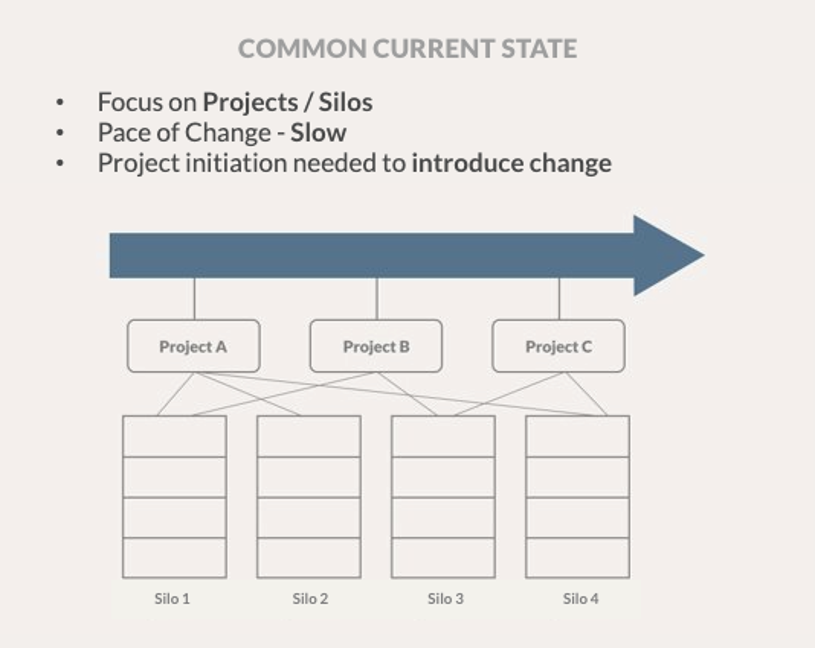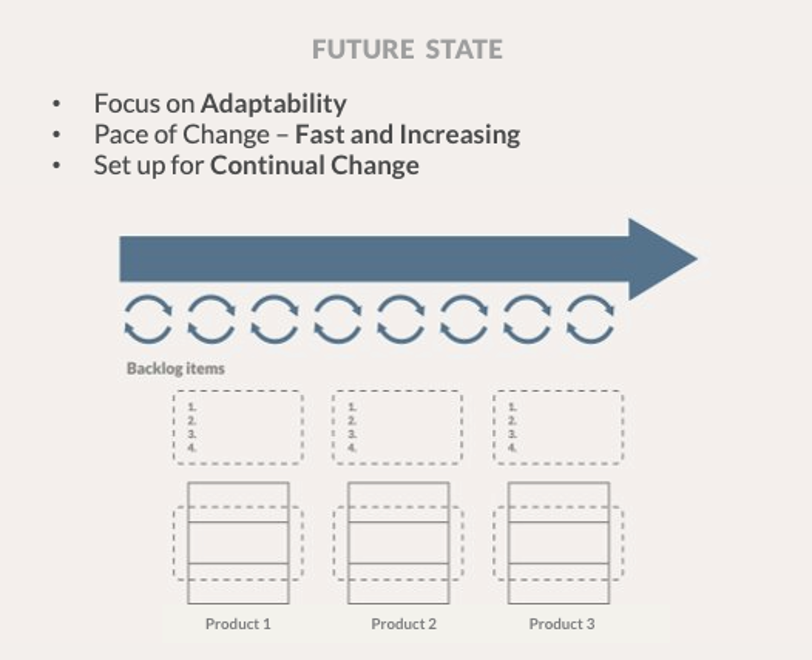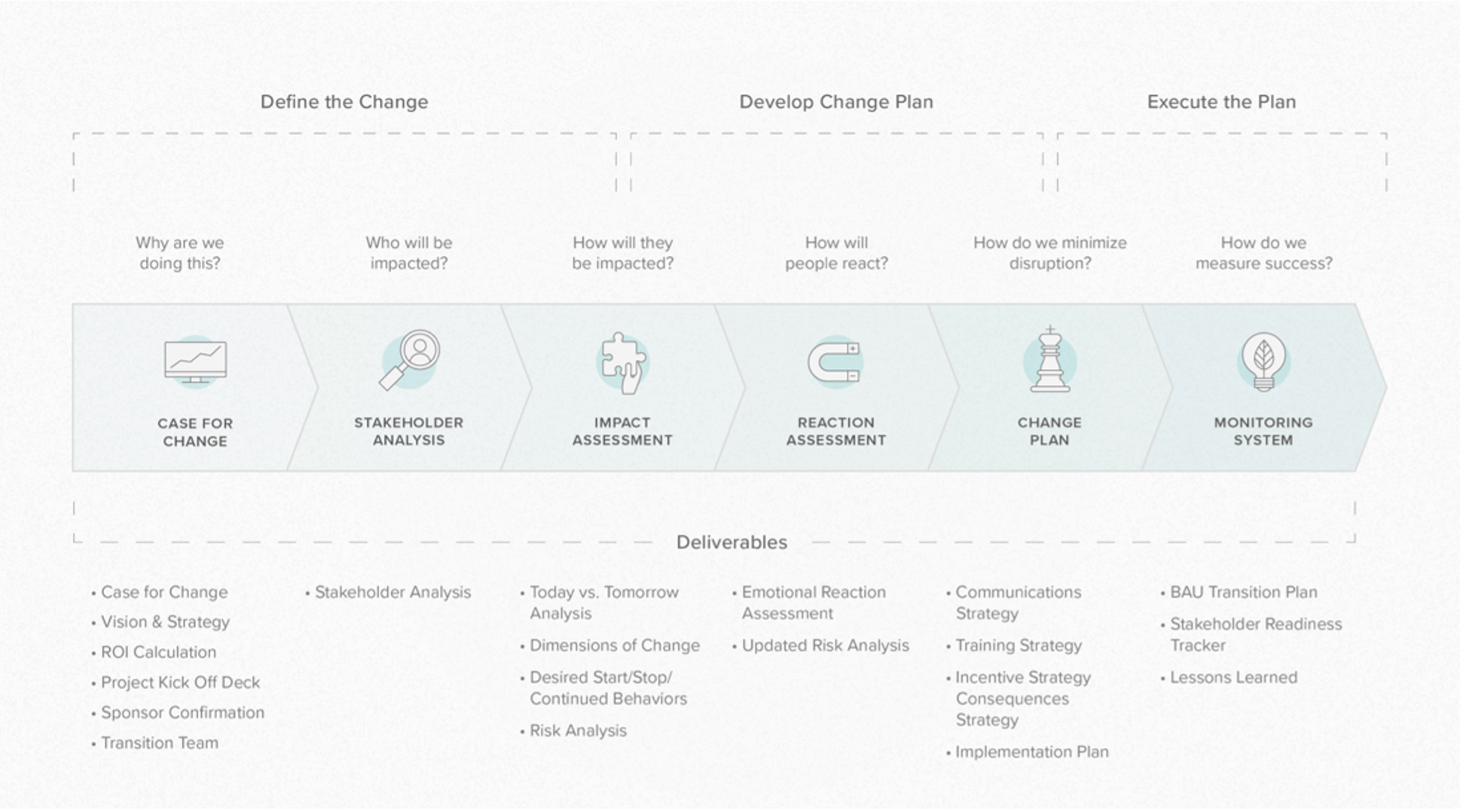Transformation
Jul 14, 2022
Agile Transformation Best Practices: Building the Business Case

Innovation and competition have created an environment where customers expect expedited changes and results. These fast-paced consumer demands have created a paradigm shift across many organizations that has left management teams seeking new ways of working. When unable to keep up with this demand, leaders across every industry are seeking ways to transform their organization, frequently choosing to undergo an agile transformation.
Agile transformation is the process of changing an organization from their current ways of working to processes that enable innovation, learning, and agility. Because of this, agile transformations are rarely a matter of reorganizing or restructuring and frequently require a shift in mindset and culture throughout the entire business. Without a shared vision and support from executive leadership, it is highly unlikely an organization will achieve a full agile transformation, and therefore will be unable to actualize the benefits of using agile.
In this piece, we will give the case for why agile transformation is particularly important and beneficial in the modern business world. Furthermore, we will cover the details of what agile looks like when implemented and conclude with a case study showing the positive effects of agile transformation.
Why Agile Transformation
There are two main reasons why agile transformation is necessary.
1. Modern Business Demands Agile Transformation
Modern consumers have come to expect and demand rapid changes; therefore, companies seek to adopt and scale themselves accordingly or they find themselves outpaced by their competition. To keep their organizations relevant and competitive, they seek methods that enable continuous improvement, growth, and higher productivity.
An agile structure creates a platform for a company to improve on a continuous basis, which increases productivity and profitability. To obtain this agile structure, companies will perform an agile transformation in hopes of enabling teams to become nimbler and increase their ability to effectively achieve business outcomes. At its core, a successful agile transformation can enable companies to achieve stability, flexibility, and create a culture of learning.
2. Agile Organizations Are More Productive and Profitable
Agile ways of working have been proven to result in higher productivity across an organization. An agile team structure means creating self-organizing, cross-functional teams that are data-driven and collaborative. This team structure has been proven to drive productivity especially when compared to a traditional organization that is static, focused on large projects that take months to complete, and structural in hierarchy. Agile team structures increase productivity because teams are focused on one task at a time and use data from previous iterations as an input to drive future project direction.
As agile spurs increased productivity, companies will begin to discover even more profound and lasting benefits because they don’t waste time delivering work their customers don’t want. Additional benefits include being able to quickly identify and respond to changing market conditions, which enables companies to be more competitive in their respective marketplace and ultimately provide more value to their customers.
See a further list of possible agile benefits in the image below:

Agile Benefits
Agile frameworks can introduce both immediate and lasting benefits, improving the quality of your work and enhancing the performance of your team long term.
The How of Agile Transformation
For agile to work, you need buy-in from employees and leadership.
1. Buy-in From Employees
While agile provides many benefits to modern organizations, conducting a successful agile transformation is not without its challenges. As mentioned previously, an agile transformation is not a simple restructuring, but instead a change in mindset from every individual touched by the transformation.
Agile transformation is a time-consuming process that requires all employees of a company to have a firm belief in the process. There may be friction or hesitation to the adaptation of an agile model because it requires changes to the current ways of working and many tend to be resistant to this type of disruption.
This shift can be especially frustrating for those who are comfortable with a traditional approach to business or do not understand the value the changes can bring. Therefore, it is critical to take a people-first approach and have active communication with the team before taking necessary steps for the agile transition.
2. Buy-in From Leadership
Moreover, a successful agile transformation requires a shared vision from leadership because the fundamental ways of working will change. Leadership needs to be empowered to transform into an agile organization because agile organizations frequently use different metrics than traditionally structured organizations to define success for their teams.
If the team is measured against outdated rules and expectations, they will not be incentivized to change their ways of working. Agile teams should be measured using outcome-driven results and their ability to deliver functional software that meets customer needs and the organization’s goals, not their ability to meet a project deadline. Because of this shift in expectations and how teams are delivering work, leaders must be fully brought into the agile transformation.
Agile Methodology
Above all, agile transformation is a shift in mindset, but there have been some specific practices developed which can be helpful in spurring the goals of agile onward. There are several ways to implement agile and use agile at your organization, including scrum, kanban, and lean management. The important thing is to focus on maximizing value and innovating quickly by using short iteration cycles and data-driven development.
Agile Team Structures
Alongside the critical culture change, effective agile transformation does involve the restructuring of a company’s governance and team structures. The below graphics demonstrate the difference between a traditional team structure and an agile team structure.
The traditional structure is static, siloed, needing explicit guidance from leadership, and is hemmed in by strict team hierarchies. Contrast that with the agile team structure, which is democratic, allows for employees to work across teams, focuses on high-priority and high-impact tasks, and adapts whenever necessary to drive toward key outcomes.

Traditional Team Structure

Agile Team Structure
A well-executed agile team will be able to quickly make decisions and adjust to project changes, enabling innovation and driving toward key outcomes. Once established, agile teams will be both stable and dynamic at the same time, which is critical for being competitive in the modern business world.
Three Approaches to Agile Transformation
There are three main approaches companies can take when pursuing agile transformation: all-in, step-wise, and emergent:
All-in: Involves an organization-wide, complete shift to agile.
Step-wise: Implement agile transformation in different teams over time.
Emergent: Target less impactful teams and bring agile to the rest of the organization over time.
Each of these approaches can be beneficial depending on the organization at hand. For example, if your organization is a very lean startup, all-in could be the approach which achieves agile transformation most effectively, whereas if you are dealing with a large, siloed, slow-moving company, consider emergent as your approach of choice.
In general, Credera recommends a more emergent approach by identifying a set of quick wins and piloting them on a specific team. Using a pilot to operationalize the changes is a portion of our change management strategy and increases the success of the transformation. If the pilot is successful, other teams are eager to learn the new ways of working and have their teams be positively impacted as well. If the pilot is less than successful, it gives us a chance to learn, adjust, and change the strategy while reducing the impact to the organization.
With each of these approaches, know that agile transformation should be an iterative and flexible process. Organizations must continuously test, improve, and learn, as they pursue the creation of an agile structure and an agile mindset. There is no one-size-fits-all way to implement agile practices, each company has to find that unique blend of what works best for them.
Agile Transformation Best Practices
We’ve used a three-phased approach when assisting companies with an agile transformation:
Current state assessment and future vision: Understand the current state of the organization’s technology, processes and organization and help craft a vision of what the future will look like with agile in place.
Transformation strategy and roadmap: Create a plan to address the gaps between the current state and the future state.
Agile pilot and rollout: Implement the transformation roadmap with a pilot program, incorporate lessons, and rollout the change across the organization.
Once the current state assessment has been completed, organizations can create a gap assessment between the current state and future vision. This gap assessment drives the strategy for how to close the gaps and actualize the future vision.
The strategy is then turned into a pilot. The implementation partner will recommend a small team or portion of the organization in which to pilot the recommended changes. Starting with a pilot will enable the team to identify wins and things that need to be adjusted. Once the strategy is finalized, the team will begin rolling out the changes across the company ensuring change management processes are enabled along the way to ensure long-term adoption and success.
Agile transformations are notoriously difficult, with many ending in failure if they aren’t holistic in approach. We’ve found that our strategic use of change management principles within our agile transformation methodology addresses all aspects of an organization as part of the transformative process.

Credera’s Change Management Approach
With this approach, Credera has helped many companies realize helpful results, including hundreds of hours of decreased toil, reduced technical complexity, and increased employee satisfaction.
A Case Study for Agile Transformation: Leading Quick Service Restaurant
A leading quick service restaurant engaged Credera to make recommendations to improve quality while reducing time to market for software deliverables. This initiative eventually led to four pilot programs to implement the recommendations. The restaurant is now much more competitive because of the decreased time to develop and deploy new initiatives resulting in improved quality and consistency.
To read more, check out our published case study.
Finding Your Next Step Toward Agile Transformation
Agile transformation offers critical benefits to modern companies. While agile is a means to achieving increased productivity, innovation, and adaptability, it is not an end. Agile is not a specific model or an exact process to follow; it is a mindset that breaks the barrier between management and employees, providing freedom to the people working in an agile organization. If you’d like to talk more about agile transformation, please reach out at marketing@credera.com.
Contact Us
Let's talk!
We're ready to help turn your biggest challenges into your biggest advantages.
Searching for a new career?
View job openings





